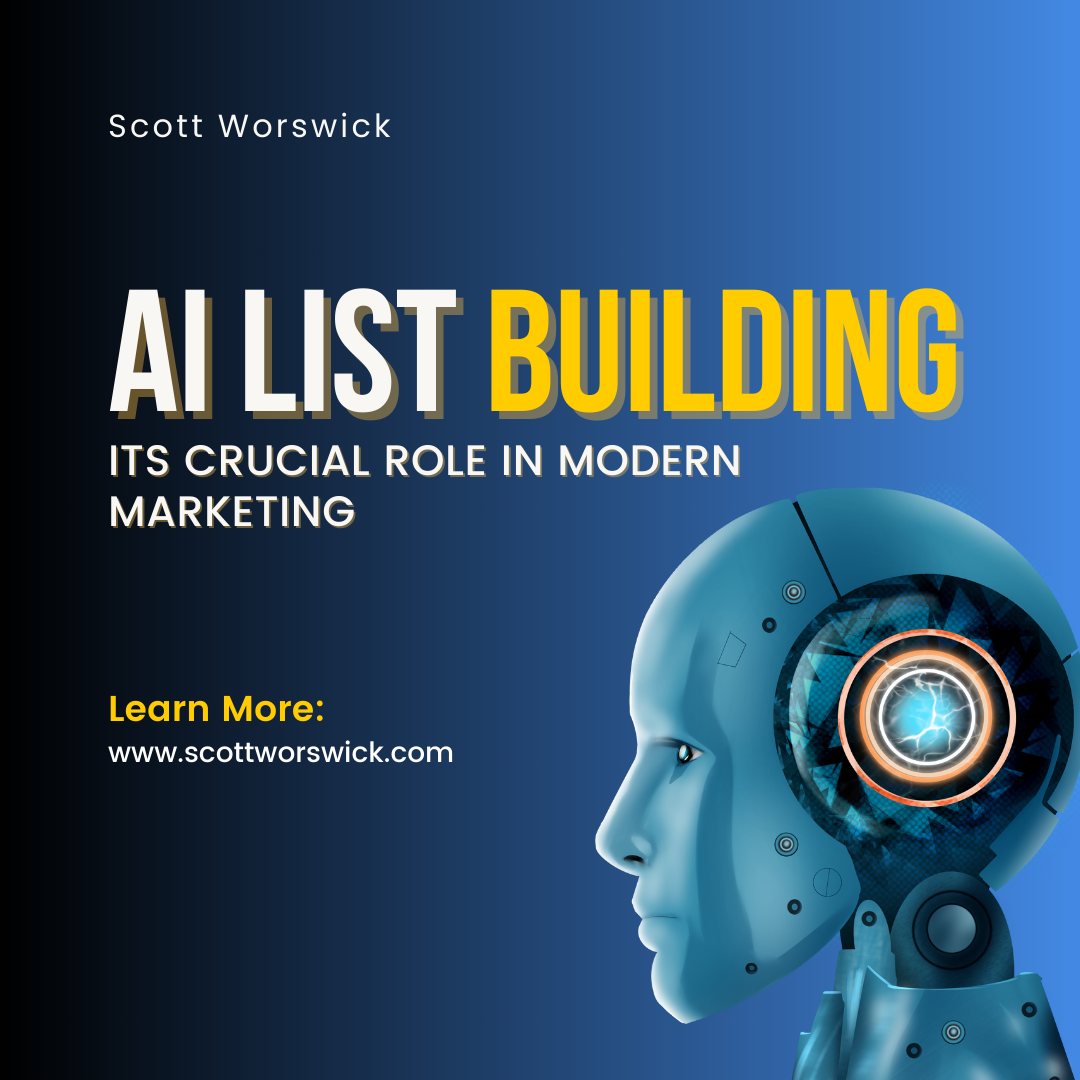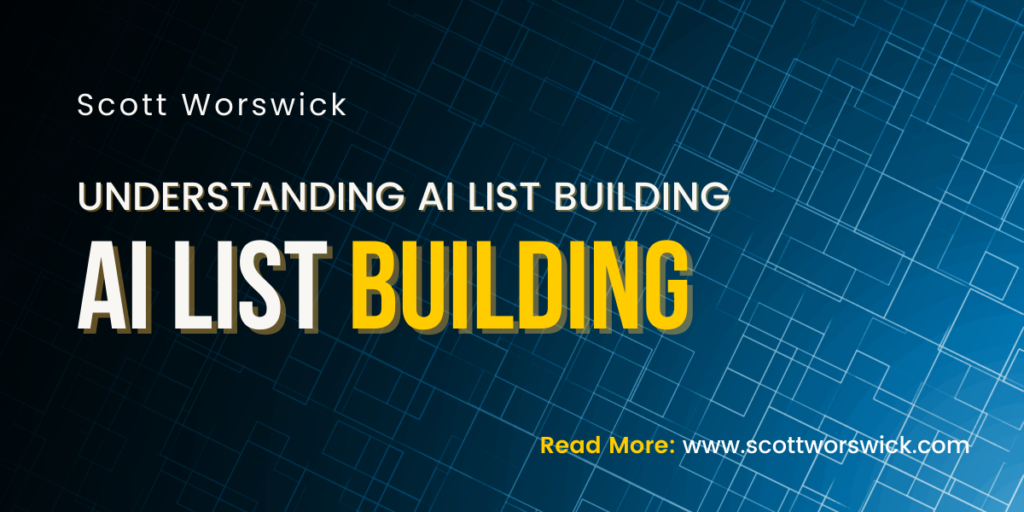In the ever-evolving landscape of modern marketing, businesses are constantly seeking innovative strategies to engage with their target audiences effectively. Amidst this quest, AI List Building emerges as a powerful tool, poised to revolutionize how companies connect with potential customers. Harnessing the capabilities of artificial intelligence, it offers a dynamic approach to audience segmentation and engagement, allowing businesses to tailor their marketing efforts with unprecedented precision and insight. By leveraging it, companies can streamline their marketing processes, optimize their resources, and drive sustainable growth in an increasingly competitive market.
At its core, it represents a convergence of technology and marketing, where algorithms sift through vast amounts of data to identify valuable prospects and curate comprehensive databases of potential leads. These databases serve as the foundation for targeted marketing campaigns, enabling businesses to deliver personalized messages that resonate with their audience on a deeper level. With AI List Building, marketers can move beyond traditional demographic segmentation to understand the nuanced preferences and behaviors of individual consumers, fostering stronger connections and driving higher engagement rates.
Furthermore, the significance of AI List Building extends beyond its ability to enhance customer engagement; it plays a crucial role in optimizing marketing return on investment (ROI). By leveraging AI algorithms to target specific audience segments with precision, businesses can allocate their resources more efficiently, minimizing wasted advertising spend and maximizing the impact of their campaigns. This strategic approach not only drives higher conversion rates but also cultivates long-term customer loyalty and advocacy, positioning businesses for sustained success in today’s rapidly evolving marketplace.
Table of Contents
1. Understanding AI List Building
In the realm of modern marketing, understanding AI List Building is paramount for businesses striving to navigate the complexities of audience engagement and conversion optimization. It represents a paradigm shift in how companies compile and manage their databases of potential customers or leads. At its core, it harnesses the power of artificial intelligence algorithms to analyze vast troves of data and identify patterns, preferences, and behaviors among consumers. This sophisticated approach enables businesses to curate highly targeted and personalized marketing campaigns, ultimately driving higher engagement and conversion rates.
With this, marketers can transcend traditional segmentation methods and delve deeper into the psyche of their target audience. By leveraging AI-powered algorithms, businesses gain insights into individual consumer preferences, allowing for the creation of hyper-personalized marketing messages. These tailored communications resonate more deeply with consumers, fostering stronger connections and increasing the likelihood of conversion. Moreover, it enables marketers to adapt their strategies in real-time, responding swiftly to changes in consumer behavior and market trends.
Furthermore, AI List Building empowers businesses to optimize their marketing ROI by directing resources toward the most promising leads. By segmenting audiences based on predictive analytics and behavioral data, companies can allocate their marketing budgets more efficiently, maximizing the impact of their campaigns. Additionally, it facilitates ongoing refinement and improvement of marketing strategies through continuous analysis and optimization. By harnessing the power of this listing, businesses can stay ahead of the competition, drive sustainable growth, and forge lasting relationships with their customers.
2. The Evolution of Marketing Strategies
In the ever-changing landscape of modern marketing, the evolution of strategies has been propelled by the advent of AI List Building. This technological innovation has revolutionized how businesses engage with their audiences, marking a significant departure from traditional methods. Historically, marketers relied on manual processes to compile and manage contact lists, a laborious and time-consuming endeavor. However, with the introduction of this listing, this process has been streamlined and enhanced, allowing for more efficient and targeted outreach efforts.
As AI List Building continues to shape the marketing landscape, it has ushered in a new era of precision and personalization. Gone are the days of generic mass marketing campaigns; today’s marketers leverage AI-powered algorithms to analyze vast amounts of data and extract actionable insights. This wealth of information enables businesses to tailor their messaging to individual preferences and behaviors, creating more relevant and impactful interactions with their audience. By understanding the unique needs and desires of their customers, companies can forge deeper connections and foster greater loyalty over time.
Moreover, the evolution of marketing strategies fueled by it extends beyond mere segmentation and personalization. It has also facilitated the rise of predictive analytics and advanced targeting techniques. By harnessing the power of machine learning algorithms, marketers can anticipate future trends and consumer behaviors with unprecedented accuracy. This foresight allows businesses to stay ahead of the curve, adapting their strategies in real-time to capitalize on emerging opportunities and mitigate potential risks. In essence, it has empowered marketers to operate with greater agility and efficiency, driving tangible results and sustainable growth in today’s competitive marketplace.
3. Enhancing Customer Engagement
In the realm of modern marketing, enhancing customer engagement is not merely a goal but a strategic imperative, and AI List Building serves as a catalyst for achieving this objective. By harnessing the power of artificial intelligence, businesses can deepen their connections with customers through personalized and relevant interactions. It enables marketers to analyze vast amounts of data, uncovering insights into consumer preferences and behaviors that drive engagement. Armed with this knowledge, companies can tailor their messaging and offerings to resonate with their target audience on a profound level.
Moreover, it facilitates proactive engagement strategies that anticipate and address the needs of customers before they arise. Through predictive analytics and machine learning algorithms, businesses can identify patterns in consumer behavior and preferences, enabling them to deliver timely and targeted communications. Whether through personalized email campaigns, targeted advertisements, or customized recommendations, it empowers marketers to engage with customers in meaningful ways, fostering loyalty and driving repeat business.
Furthermore, AI List Building enables businesses to optimize the customer journey by delivering seamless and consistent experiences across multiple touchpoints. By integrating AI-powered tools into their marketing efforts, companies can orchestrate personalized interactions that guide customers through each stage of the buying process. From initial awareness to post-purchase support, it ensures that customers receive relevant and timely communications that enhance their overall experience. This holistic approach not only increases customer satisfaction but also drives brand loyalty and advocacy in an increasingly competitive market.
In conclusion, enhancing customer engagement is paramount for businesses seeking to thrive in today’s digital age, and it provides the means to achieve this goal effectively. By leveraging artificial intelligence to analyze data, personalize communications, and optimize the customer journey, businesses can forge deeper connections with their audience, driving loyalty, and long-term success. As technology continues to advance, it will undoubtedly play an increasingly crucial role in modern marketing strategies, empowering businesses to deliver exceptional experiences and drive sustainable growth.
4. Optimizing Marketing ROI
In the dynamic landscape of modern marketing, optimizing return on investment (ROI) is a top priority for businesses, and AI List Building emerges as a powerful tool to achieve this objective. With the ever-increasing volume and complexity of data available, businesses need advanced tools to sift through this information and identify valuable insights. AI List Building enables companies to do just that by leveraging artificial intelligence algorithms to analyze data and identify patterns, trends, and opportunities. By harnessing the power of this listing, marketers can make more informed decisions, allocate resources more effectively, and ultimately drive higher ROI.
Moreover, it empowers businesses to target their marketing efforts with precision, ensuring that resources are allocated to the most promising leads. By analyzing vast amounts of data, AI algorithms can identify high-value prospects and segment them based on specific criteria, such as demographics, interests, and purchasing behavior. This targeted approach allows marketers to tailor their messaging and offers to resonate with each segment of their audience, increasing the likelihood of conversion and maximizing ROI.
Furthermore, it facilitates ongoing optimization and refinement of marketing strategies. By continuously analyzing data and monitoring campaign performance, businesses can identify areas for improvement and make adjustments in real-time. Whether it’s tweaking messaging, adjusting targeting criteria, or refining conversion pathways, it provides the insights needed to optimize marketing efforts for maximum impact. This iterative approach not only drives higher ROI but also ensures that marketing strategies remain agile and responsive to changing market dynamics.
In conclusion, optimizing marketing ROI is essential for businesses seeking to thrive in today’s competitive market, and it offers a potent solution to this challenge. By leveraging artificial intelligence to analyze data, target audiences, and optimize campaigns, businesses can maximize the effectiveness of their marketing efforts and drive sustainable growth. As it continues to evolve and mature, it will undoubtedly remain a cornerstone of modern marketing strategies, empowering businesses to achieve their goals and stay ahead of the competition.
5. Overcoming Challenges and Harnessing Opportunities
In the realm of modern marketing, AI List Building presents both challenges and opportunities for businesses striving to stay ahead of the curve. While the potential benefits of this listing are undeniable, it’s essential to acknowledge and address the challenges that come with implementing this technology. One such challenge is data privacy and security concerns. As AI algorithms rely on vast amounts of data to function effectively, businesses must ensure that they are collecting, storing, and using customer data ethically and responsibly. By implementing robust data governance practices and adhering to regulatory requirements, businesses can build trust with their customers and mitigate the risk of data breaches.
Furthermore, it introduces the risk of algorithm bias, where the algorithms may inadvertently perpetuate existing biases present in the data. To overcome this challenge, businesses must implement measures to ensure fairness and transparency in their AI systems. This includes regularly auditing algorithms for bias, diversifying training data, and involving diverse teams in the development and deployment of AI List Building solutions. By proactively addressing algorithm bias, businesses can harness the full potential of AI List Building while minimizing the risk of unintended consequences.
Moreover, AI List Building opens up a world of opportunities for businesses to innovate and differentiate themselves in the market. By leveraging AI-powered tools and techniques, businesses can gain deeper insights into customer behavior, preferences, and trends, enabling them to develop more targeted and personalized marketing strategies. Additionally, it enables businesses to automate repetitive tasks, freeing up valuable time and resources that can be reinvested into strategic initiatives. From predictive analytics to customer segmentation, it empowers businesses to unlock new efficiencies and drive sustainable growth in an increasingly competitive market.
In conclusion, while it presents challenges, it also offers immense opportunities for businesses willing to embrace innovation and adapt to change. By overcoming challenges such as data privacy concerns and algorithm bias, businesses can harness the full potential of AI List Building to enhance customer engagement, optimize marketing ROI, and drive long-term success. As technology continues to evolve, AI List Building will undoubtedly play a crucial role in shaping the future of modern marketing, empowering businesses to thrive in a rapidly changing landscape.
Conclusion
In the fast-paced world of modern marketing, AI List Building stands as a cornerstone of success, offering businesses a powerful tool to navigate the complexities of today’s consumer landscape. By harnessing the capabilities of artificial intelligence, companies can unlock new insights, optimize their marketing strategies, and drive sustainable growth. Through AI List Building, businesses can gain a deeper understanding of their target audience, enabling them to deliver personalized and relevant experiences that resonate with customers on a profound level. This level of engagement is crucial in building lasting relationships and fostering brand loyalty in an increasingly competitive market.
Furthermore, it empowers businesses to optimize their resources and maximize return on investment (ROI). By targeting high-value prospects with precision and delivering tailored messages, companies can ensure that their marketing efforts are focused on the most promising opportunities. This strategic approach not only drives higher conversion rates but also cultivates long-term customer loyalty and advocacy. Moreover, it facilitates ongoing optimization and refinement of marketing strategies, ensuring that businesses remain agile and responsive to changing market dynamics.
As businesses continue to embrace AI List Building, it’s essential to remain mindful of the challenges and opportunities that come with this technology. From data privacy concerns to algorithm bias, businesses must proactively address these challenges to build trust with their customers and maximize the benefits of this particular listing. By implementing robust data governance practices, ensuring algorithm fairness, and fostering a culture of transparency, businesses can harness their full potential while mitigating risks. In conclusion, AI List Building is not just a tool; it’s a strategic imperative for businesses seeking to thrive in today’s digital age, empowering them to connect with customers, drive growth, and stay ahead of the competition.






